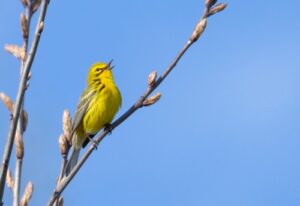(Reprinted from the Spring 2023 issue of New Hampshire Bird Records)
Spring is migration time and different birds arrive at different times. Huge concentrations can sometimes occur, but it’s often hard to know where or when. Here are a few events that often highlight May and when to watch for them.
-
Prairie Warbler by Len Medlock. The main push of warblers happens in May and it can be spectacular. Watch for south winds that can bring in a flood of birds. A few of the northern-most species won’t peak until later in the month: Blackpoll, Wilson’s, and Tennessee.
- Blue Jays are daytime migrants and in some years large number go south for the winter and begin returning in early May.
- Our eagerly-awaited Ruby-throated Hummingbirds start showing up reliably in the first week of May.
- The colorful Rose-breasted Grosbeaks, Indigo Buntings, and Baltimore Orioles arrive around May 5-10 and often come visit feeders when they first arrive, but then disappear as the weather warms.
- Although some shorebirds arrive by late April, their peak migration isn’t until mid-May. Numbers in spring generally pale in comparison to fall, but sometimes you get lucky. Most of the action is on the immediate coast, but as with other waterbirds there are sometimes significant inland fallouts associated with rainy weather.
- Mid-May is the best time to look for terns inland during their migration. Watch for inland Short-billed Dowitchers around May 20.
- Nighthawks return to nest sites around May 20-25 but migrants heading farther north can continue to mid-June.
- Of the small Empidonax flycatchers, Least are the first to arrive in early May but Alder, Willow and Yellow-bellied won’t arrive until mid to end of May.
New Hampshire Bird Records is now available in digital format free to all NH Audubon members. (Not a member yet? Join here!) All members receive an email with a link to the current issue. Printed copies are available to members for an additional fee that covers the cost of printing and postage. Details are on the New Hampshire Bird Records website.

